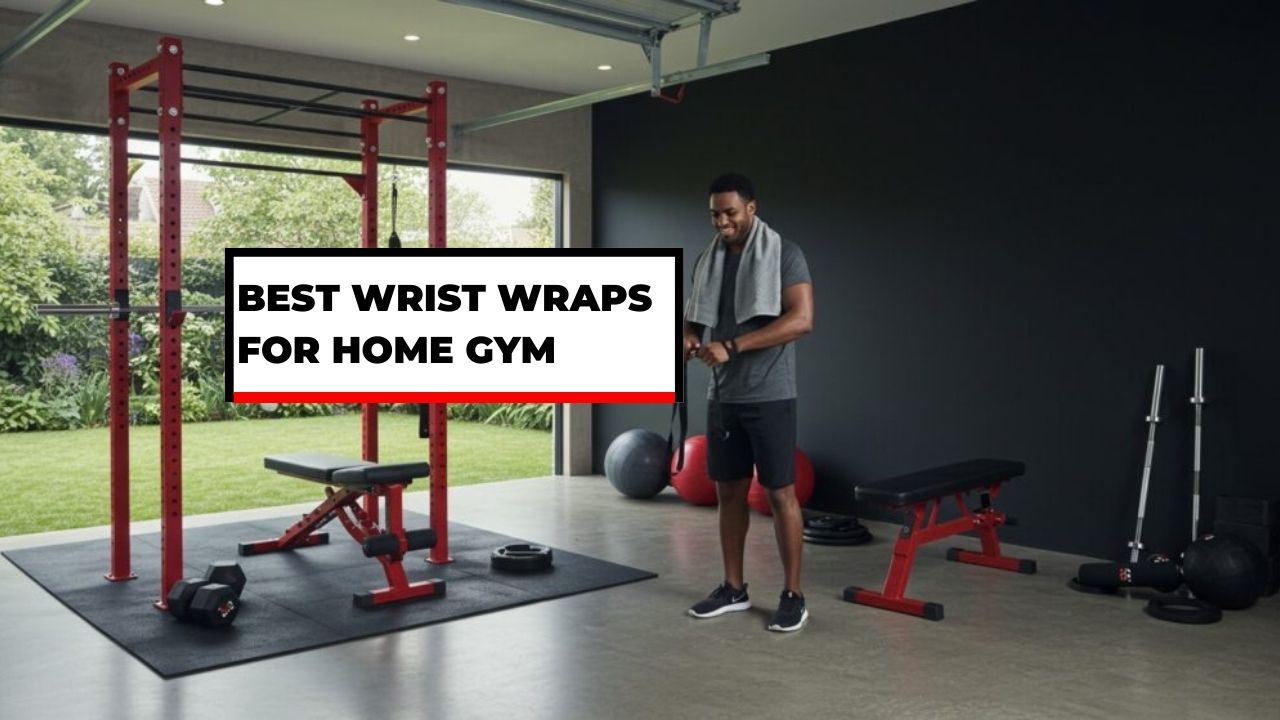Disclosure Information
This blog contains affiliate links. If you make a purchase through one of these links, our team may earn a commission at no extra cost to you. Learn more. Thanks for your support!
When you’re pushing your limits in the gym, your wrists can often become a weak link in the strength chain. Wrist wraps provide crucial support during heavy lifts, helping to stabilize the wrist joint and potentially allowing you to lift heavier weights with greater confidence. As more fitness enthusiasts build home gyms and pursue serious strength training goals, quality wrist wraps have become an essential accessory in many lifting toolkits.
Research indicates that approximately 25% of weight training injuries involve the wrist and hand area, making proper support particularly important for long-term training success.
This comprehensive guide explores everything you need to know about wrist wraps—from their benefits and types to the top products worth considering for your strength training needs.
The Quick Overview: Top Wrist Wraps for Your Home Gym
Here’s a concise rundown of the best wrist wraps, grouped by type:
Stiff/Heavy-Duty Powerlifting Wraps
- A. Inzer Iron Z Wrist Wraps: Extra-stiff, competition-approved, thumb loop.
- B. SBD Flexible: Progressive stiffness, IPF-legal, durable loop.
- C. Titan THP Wrist Wraps: Triple-ply rigidity, rebound effect, USA-made.
Medium-Stiffness/All-Purpose Wraps
- A. Rogue Fitness Wrist Wraps: Cotton-elastic blend, versatile lengths, washable.
- B. Harbinger Red Line Wrist Wraps: Durable elastic, moderate compression, affordable.
- C. Nordic Lifting Wrist Wraps: Balanced support, reinforced loops, comfy fit.
Flexible/CrossFit-Style Wraps
- A. Bear KompleX: Flexible cotton-elastic, quick-dry, multi-length.
- B. WOD Nation Wrist Wraps: Moderate stiffness, easy on/off, washable.
- C. Gymreapers Wrist Wraps: Flexible blend, durable stitching, dynamic support.
Neoprene/Hook-and-Loop Wraps
- A. ProFitness Neoprene Wrist Wraps: Comfort-focused, light support, washable.
- B. Stoic: Wide neoprene, moisture-resistant, adjustable strap.
- C. RIMSports Premium Wrist Wraps: Contoured fit, neoprene blend, broad coverage.
Wrist Wrap/Lifting Strap Combinations
- A. Schiek Lifting Straps with Wrist Supports: Padded support, nylon straps, contoured.
- B. Harbinger Red Line Wrist Wraps: NeoTek pad, non-slip straps, comfy.
- C. Versa Gripps Pro: Patented hybrid, quick-release, versatile.
Benefits of Using Wrist Wraps for Strength Training
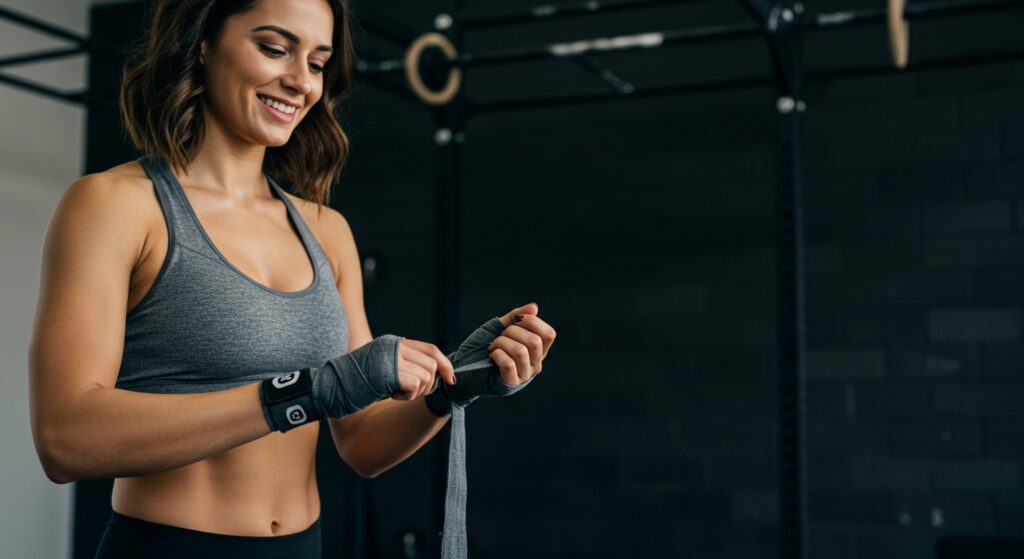
1. Joint Stabilization and Injury Prevention
The primary purpose of wrist wraps is to provide stability to the wrist joint during heavy loading. This added support:
- Helps maintain proper wrist alignment under load
- Reduces hyperextension that can lead to strain or injury
- Provides compression that enhances joint stability
- Particularly benefits those with previous wrist injuries or naturally flexible joints
Studies have shown that proper wrist support can reduce the risk of repetitive strain injuries by up to 45% among regular weightlifters.
2. Increased Lifting Confidence and Performance
With added wrist support, many lifters report:
- Greater confidence when approaching maximum lifts
- Improved ability to maintain proper form during challenging sets
- Reduced wrist pain during and after heavy training sessions
- Potential for increased training volume due to enhanced joint comfort
3. Extended Training Longevity
For long-term strength athletes, wrist wraps can contribute to training longevity by:
- Reducing cumulative stress on wrist joints over years of training
- Providing adjustable support based on the day’s training demands
- Allowing continued training through minor wrist discomfort
- Supporting rehabilitation efforts after injuries
Types of Wrist Wraps and Our Top Recommendations
1. Stiff/Heavy-Duty Powerlifting Wraps
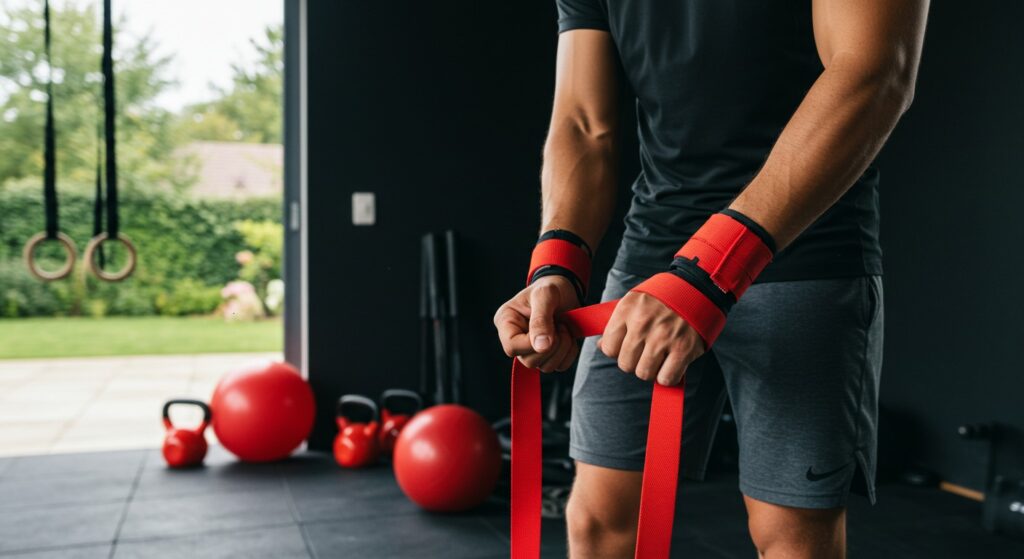
Designed specifically for maximum support during near-maximal lifts, these thick, rigid wraps prioritize stability over comfort. They’re ideal for competitive powerlifters and those focusing on strength sports where maximum wrist support is crucial for safety and performance.
Top Recommendations for Stiff Powerlifting Wraps:
- Extra-stiff construction for maximum support
- Available in 20″ and 36″ lengths for customizable coverage
- Competition-approved by most powerlifting federations
- Heavy-duty elastic with reinforced stitching
- Thumb loop design for secure placement
These wraps are favored by elite powerlifters for their exceptional rigidity and support during maximum effort bench press, overhead press, and squat attempts.
b. SBD Flexible Wrist Wraps
- Developed with and used by world champion powerlifters
- Progressive stiffness that breaks in over time while maintaining support
- Competition legal in IPF and USAPL federations
- Reinforced thumb loop that resists tearing
- Available in multiple lengths (50cm, 60cm, and 100cm)
These premium wraps strike an excellent balance between extreme support and usability, making them popular among serious competitive lifters.
- Extremely stiff triple-ply construction
- Available in 12″, 24″, and 36″ lengths
- Heavy-duty hook and loop fastening system
- Specialized weaving pattern for maximum rebound effect
- Made in the USA with competition-grade materials
These wraps provide exceptional support for maximum effort lifts while still allowing some circulatory flow to the hands.
2. Medium-Stiffness/All-Purpose Wraps
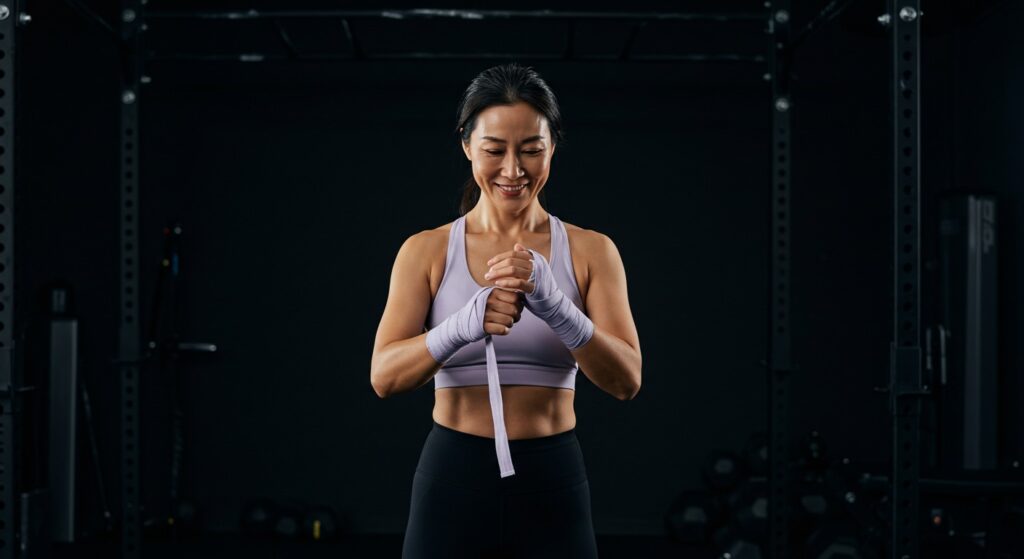
These versatile wraps offer a balance of support and comfort, making them suitable for both heavy strength work and higher-rep accessory exercises. They’re the most popular choice for general strength training and recreational lifters who want good support without extreme rigidity.
Top Recommendations for Medium-Stiffness Wraps:
- Cotton/elastic blend for balanced support
- Available in 12″, 18″, and 24″ lengths
- Thumb loop design with hook-and-loop closure
- Machine washable for easy maintenance
- Moderate stiffness suitable for various exercises
These high-quality, versatile wraps work well across different types of lifts and training styles, making them an excellent all-purpose option.
b. Harbinger Red Line Wrist Wraps
- Heavy-duty elastic with reinforced stitching
- Thumb loop for easy positioning
- Hook and loop closure for adjustable tightness
- Available in 12″ or 18″ lengths
- Moderate stiffness with good compression
These affordable, durable wraps provide reliable support for general strength training and have become a gym staple for many lifters.
- Premium cotton/elastic/polyester blend
- Reinforced thumb loops
- 14″ length suitable for most training purposes
- Balanced stiffness for support without excessive restriction
- Hook and loop closure with extra securing strap
These well-constructed wraps provide reliable support for most gym-goers without the extreme rigidity that can be uncomfortable during longer training sessions.
3. Flexible/CrossFit-Style Wraps
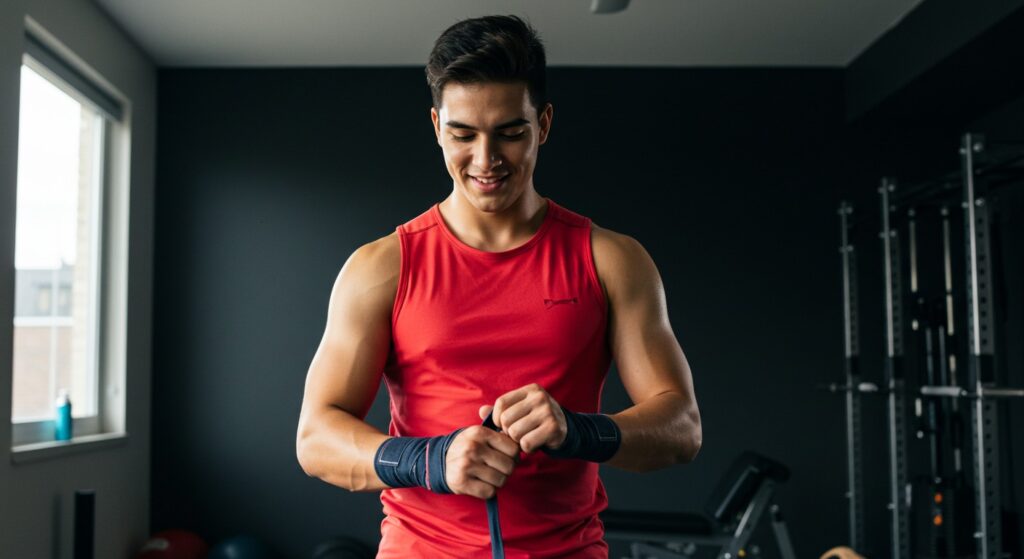
These more flexible wraps prioritize wrist support while still allowing greater range of motion and comfort during dynamic movements. They’re ideal for CrossFit athletes, Olympic weightlifters, and those who need support during exercises involving wrist flexion and extension.
Top Recommendations for Flexible Wraps:
a. Bear KompleX Wrist Wraps
- Available in both 12″ and 18″ lengths
- Cotton/elastic material with moderate flexibility
- Options for both thumb loop and traditional styles
- Suitable for high-rep Olympic lifts and gymnastics movements
- Quick-dry material for minimal moisture retention
These wraps have become particularly popular in the CrossFit community for their versatility across different movement patterns.
- Elastic material with moderate stiffness
- 12″ or 18″ length options
- Quick-adjust thumb loop design
- Machine washable for easy maintenance
- Designed for quick on/off between different exercises
These affordable wraps provide good support for Olympic lifting, gymnastics movements, and general training without restricting mobility.
- Cotton/elastic/polyester blend for flexibility with support
- Available in 12″, 18″, and 24″ lengths
- Reinforced thumb loops
- Heavy-duty stitching for durability
- Moderate flexibility suitable for dynamic movements
These reasonably priced wraps offer good balance between support and mobility, making them suitable for varied training styles.
4. Neoprene/Hook-and-Loop Wraps
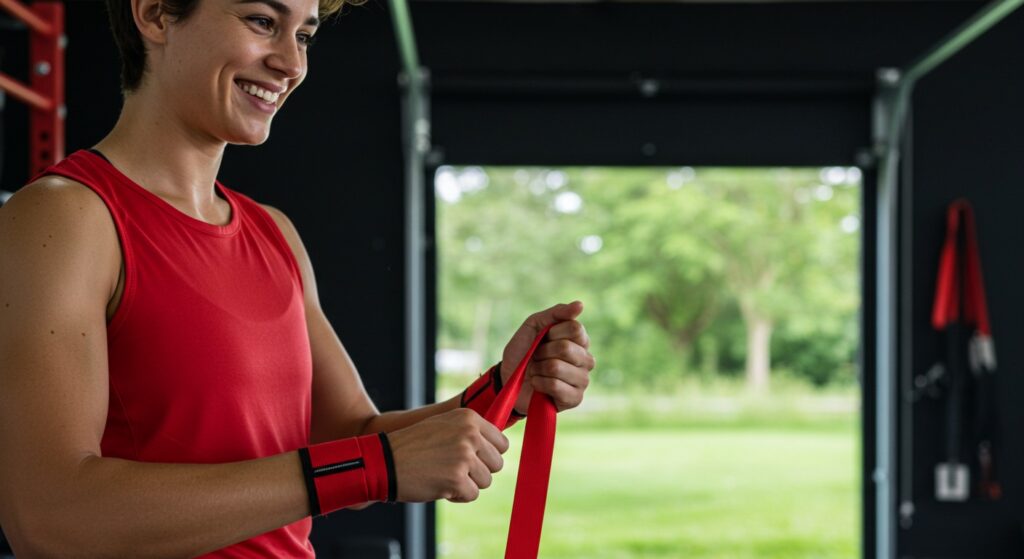
These wraps typically use neoprene or similar materials with hook-and-loop closures for quick and easy adjustment. They provide moderate support with maximum comfort and are ideal for beginners or those needing mild to moderate wrist stability.
Top Recommendations for Neoprene Wraps:
a. ProFitness Neoprene Wrist Wraps
- Neoprene construction for comfort and light support
- Hook-and-loop closure for easy adjustment
- Thumb loop design for secure placement
- Machine washable
- More comfortable for extended wear than traditional wraps
These lightweight wraps provide good protection for beginners and those needing just moderate support during general training.
b. Stoic Wrist Wraps
- Premium neoprene with reinforced stitching
- Extra-wide design for broader coverage
- Quick-adjust strap system
- Moisture-resistant material
- Balanced support without excessive restriction
These well-constructed neoprene wraps provide reliable support for general strength training while prioritizing comfort.
c. RIMSports Premium Wrist Wraps
- Neoprene-blend material for durability and support
- Contoured design that fits wrist anatomy
- Extra-wide hook-and-loop closure
- Thumb loop for easy positioning
- Suitable for both men and women
These anatomically designed wraps provide good support while being particularly comfortable for longer training sessions.
5. Wrist Wrap/Lifting Strap Combinations
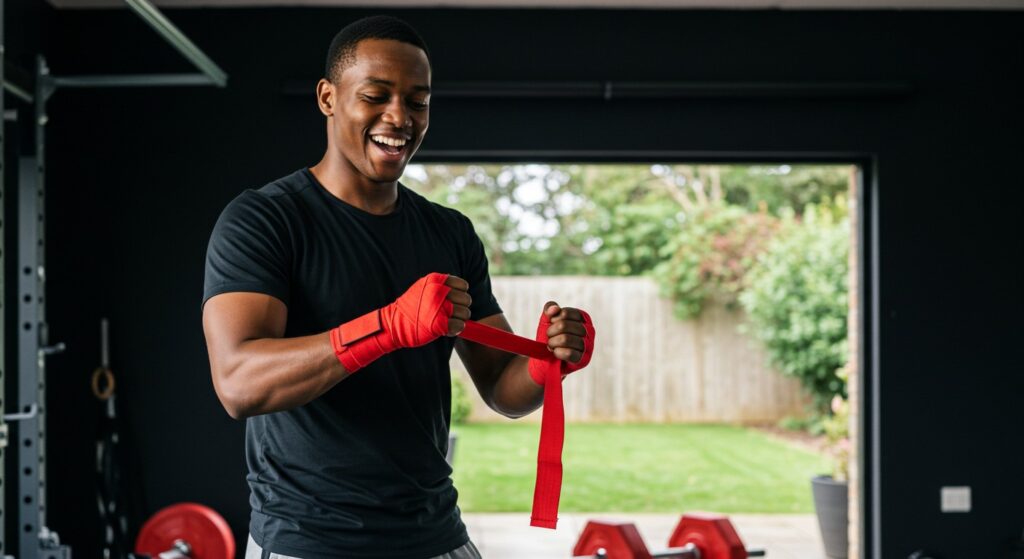
These hybrid products combine wrist support with integrated lifting straps, providing both wrist stability and improved grip for pulling exercises. They’re ideal for those who want an all-in-one solution for supporting both wrists and grip.
Top Recommendations for Wrap/Strap Combinations:
a. Schiek Lifting Straps with Wrist Supports
- Padded wrist support with integrated lifting straps
- Premium nylon construction
- Contoured design that follows wrist anatomy
- Reinforced stitching at stress points
- Suitable for deadlifts, rows, and other pulling movements
These hybrid straps provide excellent wrist support while also enhancing grip during heavy pulling exercises.
b. Harbinger Big Grip Pro Lifting Straps with Wrist Supports
- NeoTek cushioned wrist pad for comfort
- Heavy-duty cotton straps with non-slip coating
- Extended length for secure wrap around barbell
- Reinforced stitching for durability
- Balanced support without restricting circulation
These combination products excel for deadlifts and other pulling movements where both grip and wrist support are beneficial.
- Premium patented design combining wrist support and grip aid
- Non-bunching palm pad for comfortable weight distribution
- Reinforced wrist support section
- Quick-release system for safety
- Versatile for both pushing and pulling movements
Though pricier than traditional options, these innovative grip/support hybrids provide excellent functionality for various exercises.
Key Features to Look for in Quality Wrist Wraps
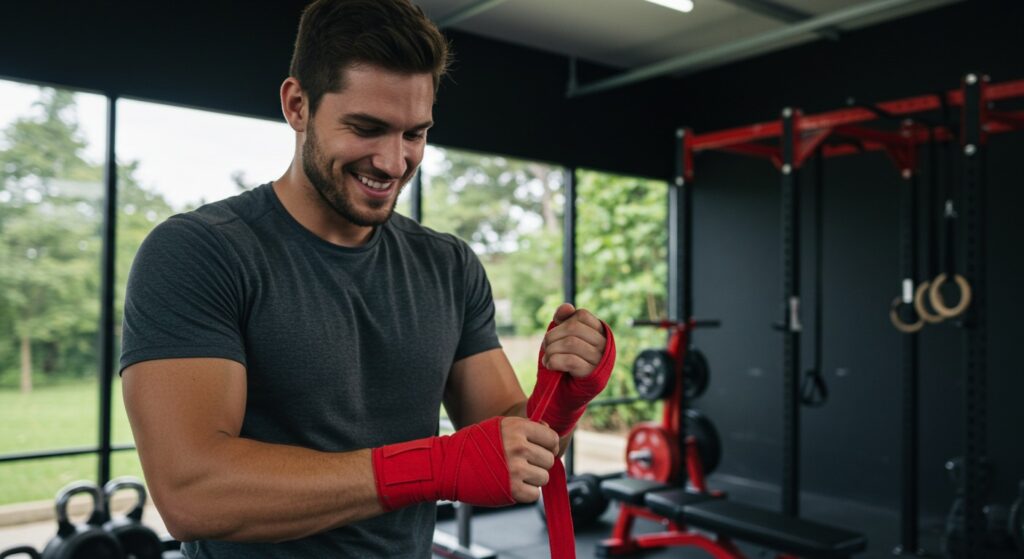
Material and Construction
The materials used significantly impact both the support level and comfort:
- Cotton/elastic blends: Provide good support with some flexibility
- Neoprene: Offers comfort and moderate support with excellent durability
- Heavy-duty elastic: Delivers maximum support for powerlifting
- Stitching quality: Reinforced stitching at stress points enhances durability
Length Options
Wrist wrap length affects both the level of support and versatility:
- 12″-14″ (30-35cm): Suitable for general training and beginners
- 16″-20″ (40-50cm): Provides balanced support for intermediate lifters
- 24″-36″ (60-90cm): Delivers maximum support for competitive powerlifters
Longer wraps allow for more revolutions around the wrist, generally providing greater support but potentially restricting blood flow if wrapped too tightly.
Closure Systems
Different fastening methods offer varying levels of security and adjustability:
- Hook-and-loop (Velcro): Provides quick adjustments and secure closure
- Thumb loop: Helps maintain proper positioning during wrapping
- Traditional vs. quick-release designs: Affect how rapidly you can adjust or remove the wraps
Width and Thickness
The width and thickness of wrist wraps impact both support level and comfort:
- Wider wraps (3″-4″) provide more coverage and typically more support
- Thicker materials generally offer more rigidity and support
- Thinner wraps may be more comfortable but provide less stabilization
How to Choose the Right Wrist Wraps for Your Training Style

Assessing Your Lifting Focus
Your primary training style should guide your wrap selection:
- Powerlifting: Choose stiffer, longer wraps for maximum support
- Olympic weightlifting: Select more flexible wraps that allow wrist extension
- CrossFit/functional fitness: Look for versatile, moderate-stiffness wraps
- General strength training: Medium-stiffness wraps typically work well
- Rehabilitation: Consult with a healthcare provider, often neoprene wraps are recommended
Budget Considerations
Wrist wraps vary significantly in price:
- Budget options ($10-15): Suitable for beginners or occasional use
- Mid-range ($15-30): Offer good durability and support for most trainees
- Premium ($30-50+): Provide professional-grade support and longevity
While quality wraps are generally worth the investment, beginners can often start with moderately priced options and upgrade as their lifting advances.
Competition Requirements
If you compete in strength sports, check your federation’s rules regarding:
- Maximum wrap length allowed in competition
- Approved brands and models
- Rules regarding thumb loops and closure systems
- Color restrictions (some federations require specific colors)
Proper Usage and Technique
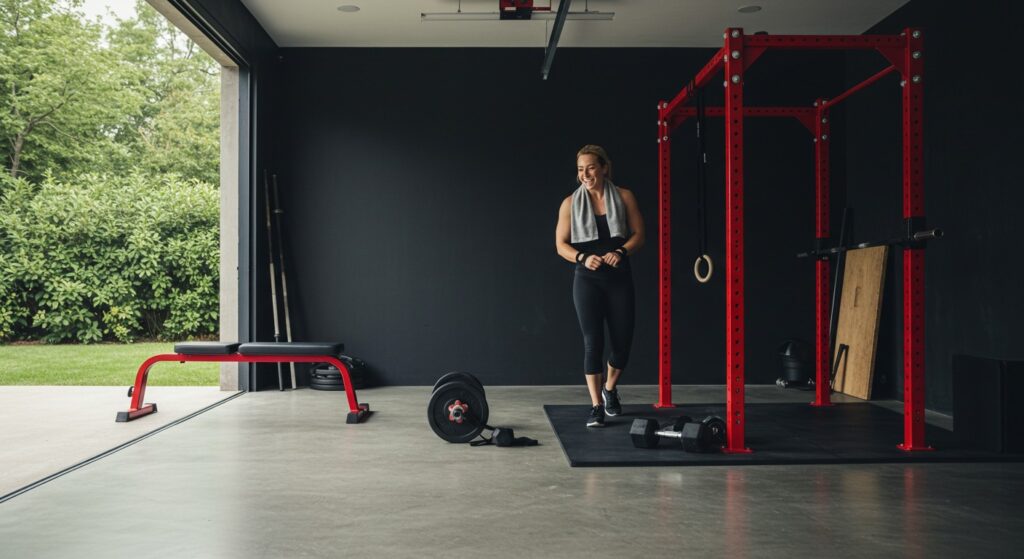
How to Wrap for Maximum Support
To get the most benefit from your wrist wraps:
- Position the thumb loop over your thumb with the wrap on the inside of your wrist
- Pull the wrap taut and begin wrapping around your wrist
- Overlap each layer evenly, working up from the base of your hand
- For maximum support, wrap tighter with slight tension on the material
- Secure the closure without cutting off circulation
- Adjust tightness based on the exercise and weight being used
When to Use Wrist Wraps
For optimal training benefit, consider using wraps:
- During your heaviest sets of pressing movements
- When performing overhead lifts with challenging weights
- If you’re experiencing minor wrist discomfort
- During rehabilitation from wrist injuries (with medical clearance)
- In competition settings where maximum performance is the goal
Many experienced lifters save their wraps for sets above 80-85% of their maximum to avoid becoming dependent on them for all training.
Common Mistakes to Avoid
To maximize effectiveness and safety:
- Don’t wrap too high on the hand, which can restrict finger movement
- Avoid wrapping so tightly that you cut off circulation
- Don’t become dependent on wraps for all exercises
- Replace wraps when elasticity diminishes or stitching fails
- Remove wraps between sets on longer training sessions to restore circulation
Maintenance and Care for Wrist Wraps
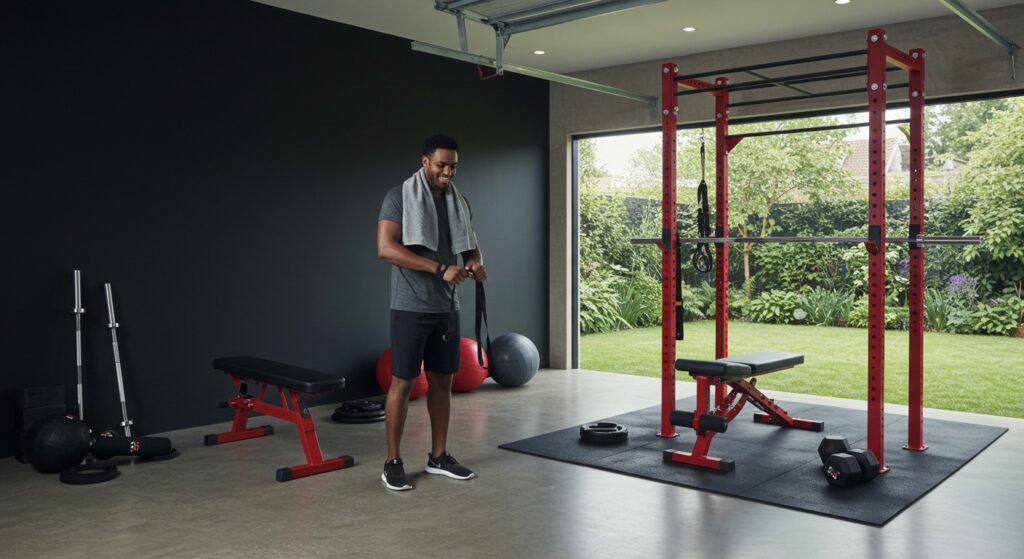
Cleaning Best Practices
To maintain hygiene and extend the life of your wraps:
- Allow wraps to air dry after sweaty training sessions
- Follow manufacturer washing instructions
- For most cotton/elastic wraps: machine wash cold in a garment bag and air dry
- For neoprene wraps: hand wash with mild soap and air dry
- Avoid bleach or harsh detergents that can break down elastic
Extending Wrap Lifespan
Quality wraps should last 1-3 years with proper care:
- Rotate between two pairs for frequent lifters
- Re-roll wraps properly after use instead of stuffing them into a bag
- Store in a dry environment to prevent mildew
- Repair minor damage to stitching before it worsens
- Hand wash premium wraps to preserve elasticity
Alternatives and Complementary Support Methods
Wrist Sleeves
Neoprene wrist sleeves provide consistent compression and warmth without the extreme support of wraps. They’re excellent for:
- Those with arthritis or chronic wrist issues
- Maintaining warmth in joints during longer sessions
- Providing light support during higher-rep work
Lifting Straps
For pulling exercises where grip is the limiting factor, lifting straps can be used independently or alongside wrist wraps to:
- Reduce grip fatigue during high-volume pulling
- Allow focusing on targeted muscles rather than grip
- Support heavier loads in deadlifts and rows
Wrist Mobility Work
Complementing wrist wraps with proper mobility can enhance joint health:
- Regular wrist stretching and mobility drills
- Forearm strengthening exercises
- Proper warm-up protocols before heavy lifting
- Active recovery techniques between training sessions
Common Myths About Wrist Wraps
“Wrist Wraps Will Weaken Your Joints”
Many beginners worry that using supportive gear will lead to weakness. However, when used appropriately for challenging loads, wraps can actually:
- Allow proper training stimulus to target muscles without joint limitation
- Reduce injury risk that would interrupt training progress
- Enable more total training volume for better overall development
“All Wrist Wraps Provide the Same Support”
As our detailed product section demonstrates, significant differences exist between wrap types in terms of:
- Stiffness and support level
- Material composition and durability
- Design features that affect functionality
- Quality of construction affecting longevity
“Only Beginners Need Wrist Support”
In reality, many elite and professional lifters use wrist wraps regularly because:
- Joint protection becomes more important as loads increase
- Competitive performance benefits from maximum joint stability
- Training longevity is enhanced through appropriate support
- Even strong wrists benefit from added stability under maximum loads
Conclusion: Invest in the Right Wrist Wraps for Your Training
Choosing the right wrist wraps represents an important decision for serious strength trainees. By understanding the different types available and assessing your specific needs, you can find the perfect pair to enhance your training experience and potentially extend your lifting career.
Remember that the best wrist wraps for you will depend on your individual training style, joint structure, and performance goals. Many experienced lifters eventually own multiple pairs for different training purposes—stiffer wraps for maximum attempts and more flexible ones for general training.
With proper selection, usage, and care, quality wrist wraps can provide years of joint protection and performance enhancement, making them a worthwhile investment for any dedicated strength athlete.

